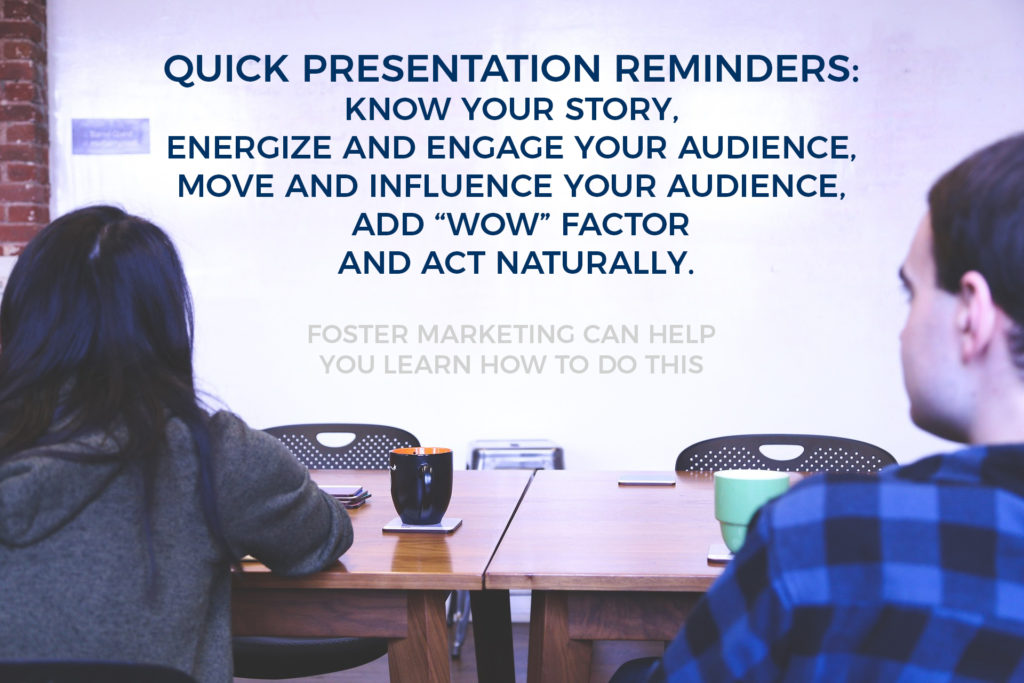No matter where you’re presenting – to an oilfield conference, your company’s board of directors or your blog or Twitter group, adding a little something extra could make a significant impact.
What is it that causes a group to remember one person’s presentation and quickly forget another’s? The style and content may not even be all that unique. With similar content, something else makes the difference: the way content is presented.
The First Question
The first question to ask when planning a presentation is to determine what your story will be. Stay out of the presentation software until you’ve done the hard work and you have something really great to present.
Once you’ve assembled a great story, now it’s time to decide how to present your ideas. If you’re thinking your next step is developing your standard PowerPoint slide show, it may be time to rethink your presentation options.
Slide decks are yesterday’s presentation method. What could be more boring than watching a dull, uninspired slide deck inherited from the last presenter? Sure, it’s possible to teach that way, but it’s no fun – and not very memorable. Unless your audience is taking notes, your presentation will soon be a distant memory.
We are constantly exposed to fantastic videos, animations and visual creativity – in movies, video clips, commercials and even Internet posts. So, with an audience inundated with creative stimuli, how do you make your presentation as exciting and memorable as your presentation content?

Build Excitement
Think about the memorable presentations you’ve attended. What was different? Maybe the speaker was more animated and didn’t rely on slides. Maybe he or she engaged the audience in a lively conversation or introduced a game. When your audience takes an active role, the information sticks.
Speeches are a lot more fun to watch when the speaker is energized and engaging. People also pay closer attention and retain more. Chances are if you’ve ever fallen asleep during a presentation, the presenter’s style had more to do with it than the content. Following are some ways to spice up your presentation:
- Don’t overdo it. Don’t overuse gestures and body language or do goofy things to get the audience’s attention like shout or throw excess humor into your presentation. Simply be excited about your presentation and do what feels natural.
- Excitement and enthusiasm. The pair can make a good speech great, and sometimes even help overcome less exciting subject matter. Be excited about your topic and the fact that you’re able to share it with your audience to keep them engaged. Figure out what excites you about the topic and use it to fuel your presentation.
- You’ve worked hard. It feels good to present something you’ve worked hard on. If you’ve taken the time to prepare and practice, your confidence and commitment to the effort will show.
- Explore new content flows. Find a way to tell your story in a way that will resonate with your audience’s business problems and specific industry to make your story real for them.
- Explore visual storytelling. Visuals are a powerful way to connect with your audience. Finding a visual storytelling angle opens up new ways to tell your story. Show your product in action or a brief video testimonial; the more you engage different senses, the easier it is to be memorable.
- Stand out in the crowd. The most successful presentations find creative new ways to engage viewers. Look for opportunities to shake things up a little. You have to relate to your audience – to their needs, to their desires and to their open and hidden agendas. Listen to your audience, observe them, question them, confirm what you are told and deal with any objections.
Create a Presence
When speaking to a group, you are on stage. Presence is the ability to move and influence your audience; to make every member of an audience feel that you are speaking directly to them.
Was I “On?”
The keys to being “on” are: be your one-on-one self; be prepared; master the fundamentals and nuances of speaking to a group; then be comfortable and make your audience comfortable with you. Some people have natural stage presence. For those of us who don’t, the first step is to realize that your one-on-one self is your best bet.
- Prepare fully and carefully. Nervousness is easier to overcome if you know what you’re talking about. Remember, you wouldn’t be giving the presentation unless your audience was interested in what you have to say.
- Dress appropriately for the presentation, not too casually or too formally. Some initial research should give you an idea of what to wear.
- Make eye contact with as many different members of the audience as possible and be careful with your body language. Don’t show negative reactions on your face. Don’t look at your watch.
- Move around if you can. This adds life to your presentation and also helps decrease the psychological distance between presenter and audience.
- Don’t speak in a monotone voice. Put life in your voice.
Looking for the Extra “Wow” Factor
The “wow” factor is that little extra that helps to make your presentation memorable. Tools are what you make of them. If you use PowerPoint correctly (only to illustrate your key points, not to display boring lists of bullets), PowerPoint can provide presentations that are memorable and effective. But try stepping outside your PowerPoint comfort zone if you really want to stand out from the rest.
- Paper the walls. Use giant Post-it pages rather than slides. Break your ideas into “bite-size” visuals. You’ll build a progressive presentation that gains strength with each page.
- Whiteboard it. A picture is worth a thousand slides … think about how you can visually “explain” the idea.
- Put it on video. High-impact video segments add interest and authority to your presentation. Customer interviews and from-the-field clips can have a memorable impact.
- iPad it. Make your presentations interactive by using available technology. Plus, this makes it shareable.
- Share your presentation. Share your presentation “in the cloud” with software like Prezi, an app that allows non-linear presentations with added creative elements, typography, etc. to zoom, pan, import media, add motion buttons to control the presentation sequence, and generally “amp up” your presentation, as well as display your tech know-how.
Just remember whatever you do, know your stuff and act naturally.
Foster Marketing has been helping companies amp up their presentations for decades. Need a little extra help to add the impact you are after? Call us at 281-448-3435.
